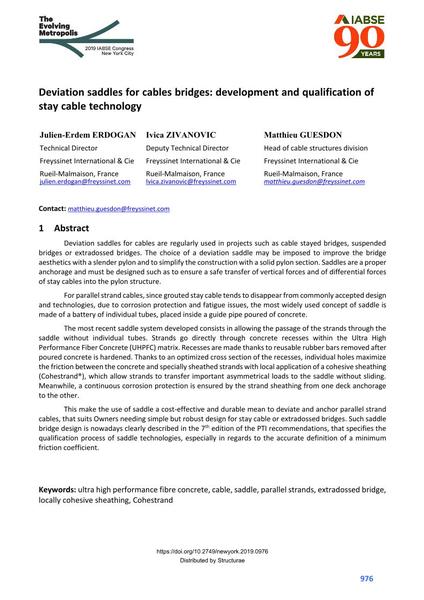Deviation saddles for cables bridges: development and qualification ofstay cable technology

|
|
|||||||||||
Détails bibliographiques
| Auteur(s): |
Julien-Erdem Erdogan
(Freyssinet International & Cie)
Ivica Zivanovic (Freyssinet International & Cie) Matthieu Guesdon (Freyssinet International & Cie) |
||||
|---|---|---|---|---|---|
| Médium: | papier de conférence | ||||
| Langue(s): | anglais | ||||
| Conférence: | IABSE Congress: The Evolving Metropolis, New York, NY, USA, 4-6 September 2019 | ||||
| Publié dans: | The Evolving Metropolis | ||||
|
|||||
| Page(s): | 976-983 | ||||
| Nombre total de pages (du PDF): | 8 | ||||
| DOI: | 10.2749/newyork.2019.0976 | ||||
| Abstrait: |
Deviation saddles for cables are regularly used in projects such as cable stayed bridges, suspended bridges or extradossed bridges. The choice of a deviation saddle may be imposed to improve the bridge aesthetics with a slender pylon and to simplify the construction with a solid pylon section. Saddles are a proper anchorage and must be designed such as to ensure a safe transfer of vertical forces and of differential forces of stay cables into the pylon structure. For parallel strand cables, since grouted stay cable tends to disappear from commonly accepted design and technologies, due to corrosion protection and fatigue issues, the most widely used concept of saddle is made of a battery of individual tubes, placed inside a guide pipe poured of concrete. The most recent saddle system developed consists in allowing the passage of the strands through the saddle without individual tubes. Strands go directly through concrete recesses within the Ultra High Performance Fiber Concrete (UHPFC) matrix. Recesses are made thanks to reusable rubber bars removed after poured concrete is hardened. Thanks to an optimized cross section of the recesses, individual holes maximize the friction between the concrete and specially sheathed strands with local application of a cohesive sheathing (Cohestrand®), which allow strands to transfer important asymmetrical loads to the saddle without sliding. Meanwhile, a continuous corrosion protection is ensured by the strand sheathing from one deck anchorage to the other. This make the use of saddle a cost-effective and durable mean to deviate and anchor parallel strand cables, that suits Owners needing simple but robust design for stay cable or extradossed bridges. Such saddle bridge design is nowadays clearly described in the 7thedition of the PTI recommendations, that specifies the qualification process of saddle technologies, especially in regards to the accurate definition of a minimum friction coefficient. |
||||
| Mots-clé: |
câble pont extradossé
|
||||
